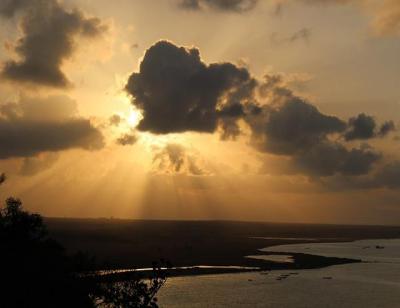The inhabitants are of
Arab,
Somali, and
South Asian origins. They follow the
Islamic faith and speak
Soqotri, a
Semitic language. Their primary occupations have been fishing,
animal husbandry, and the cultivation of
dates. Almost all inhabitants of Socotra, numbering nearly 50,000,
[9] live on the homonymous main island of the archipelago. The principal city,
Hadiboh (with a population 8,545 at the
census of 2004), the second largest town, Qulansiyah (3,862), and Qād̨ub (929)
[citation needed] are all located on the north coast of the island of Socotra. Only a few hundred people live on the islands of 'Abd-al-Kūrī and Samha; the island of Darsa and the
islets of the archipelago are uninhabited.
[citation needed]
The archipelago forms two
districts of the
Hadhramaut Governorate:
- the district of Hadībū (حديبو), with a population of 32,285 and a district seat at H̨adībū, consists of the eastern two thirds of the main island of Socotra;
- the district of Qulansiyah wa 'Abd-al-Kūrī (قلنسيه وعبد الكوري), with a population of 10,557 and a district seat at Qulansiyah, consists of the minor islands (the island of 'Abd-al-Kūrī chief among them) and the western third of the main island.
Monsoons long made the archipelago inaccessible from June to September each year. However, in July, 1999, a new airport opened Socotra to the outside world year round, with both
Yemen Airways and
Felix Airways providing flights once a week to
Aden and everyday to
Sana'a. All flights stop at
Riyan-Mukalla Airport (
ICAO code "RIY"). Socotra Island Airport ("OYSQ") is located about 12 km west of the main city, H̨adībū, and close to the third largest town in the archipelago, Qād̨ub.
[14] Diesel generators make electricity widely available in Socotra, but even in
Hadiboh there is no electricity from 5:00 A.M. until 9:00 A.M. daily.
[citation needed] An excellent paved road runs along the north shore from Quelensiyah to Hadiboh and then to DiHamri area; and another paved road, from the northern coast to the southern through the Dixsam Plateau.
[citation needed] Public transport is limited in Socotra; taxis are available only as a kind of rent-a-car service of four-wheel-drive vehicles with drivers.
[citation needed]
The former capital is located to the east of Hadiboh. A small Yemeni Army barracks lies at the western end of Hadiboh, and the President of Yemen,
Ali Abdullah Saleh, has a residence there.
[citation needed]
The Semitic language
Soqotri, spoken originally only in Socotra, is related to such other
Modern South Arabian languages on the Arabian mainland as
Mehri, Harsusi,
Bathari, Shehri, and
Hobyot. Soqotri is also spoken by minority populations in the
United Arab Emirates and other
Gulf states.
Some residents raise cattle and goats. The chief export products of the island are
dates,
ghee,
tobacco, and
fish.
At the end of the 1990s, a
United Nations Development Program was launched with the aim of providing a close survey of the island of Socotra.
[citation needed]
The majority of male residents on Socotra are reported to be in the J* subclade of Y-DNA haplogroup J. Several of the female lineages on the island, notably those in mtDNA haplogroup N, are found nowhere else on earth.













